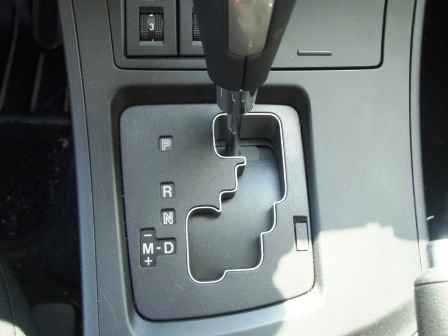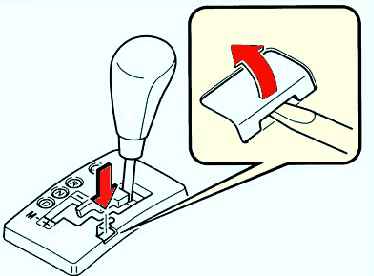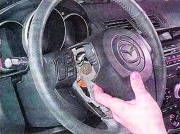The starter can be turned on if the range switch is in the "P" (parking) or "N" (neutral) position (Fig. 1.)
In the "P" (parking) position of the range switch, the front wheels are mechanically blocked from rotation.

Putting the range selector in P (Park), N (Neutral), or R (Reverse) while the vehicle is moving can damage the transmission.
Putting the range selector lever in the "D" (drive) or "R" (reverse) position while the engine is running above idle can damage the transmission!

If the lever is in the "R" (Reverse) position, reverse gear is engaged and the vehicle can move backward.
Engaging and disengaging reverse gear is necessary only after the vehicle has come to a complete stop.
The exception is in rare cases when it is necessary to get the car out of a jam using rocking.
In the "N" (Neutral) position, none of the gears in the transmission is engaged, and the front wheels are disconnected from the engine.
The car can roll freely even on a slight slope of the road, if the parking brake is not applied or the brake pedal is not depressed.
To prevent the vehicle from moving unexpectedly, apply the parking brake or depress the brake pedal before moving the range selector lever out of the N (Neutral) position.
The "D" (driving) range is for normal driving conditions.
After starting the car and as it accelerates, automatic sequential gear changes occur - from first to fourth.
Position "M" (shifting in manual mode) is intended for manual gear shifting.
The driver can sequentially shift the transmission to higher or lower gears by moving the lever in the appropriate direction.
Range lever lock
The locking system prevents the lever from being moved out of the "P" (parking) position unless the brake pedal is depressed.
To move the lever out of the "P" (parking) position, follow these steps.
- 1. Press and hold the brake pedal.
- 2. Start the engine.
- 3. Move the range selector lever.
The range selector lever cannot be moved out of the "P" (park) position when the ignition switch is in the "ACC" (auxiliary consumers) or "LOCK" (lock) position.
As a safety precaution, the ignition key cannot be removed from the ignition switch unless the range selector lever is in the P (Park) position (Vehicles with the "Advanced Key" wearable card)
The ignition switch cannot be turned from the "ACC" (auxiliary consumers) position to the "LOCK" (lock) position unless the range selector lever is in the "P" (parking) position.
Disable Range Lever Lock
If the range selector lever cannot be moved out of the "P" (park) position in the usual way, while holding the brake pedal depressed, do the following.
Use a screwdriver to remove the lock switch cap.

Insert a screwdriver into the recess and press the screwdriver down (Fig. 2.).
Move the range selector lever.
Manual shift mode
The manual shift mode allows to some extent simulate the operation of a manual transmission and gives the driver the ability to control the engine speed and torque supplied to the drive wheels.
To enter manual shift mode, move the shift lever from the "D" (drive) position to the "M" (manual shift) position.
To return to automatic shift mode, move the lever from position "M" (shift in manual mode) to position "D" (drive).
If the manual gearshift mode is on, the "M" indicator of manual control mode will be lit on the instrument panel.
Gear indicator

The number of the selected gear is lit on the dashboard (Fig. 3).
If downshifting is not possible due to vehicle speed being too high, the gear indicator will blink twice.
If the working fluid (ATF) overheats, the automatic transmission may switch from manual to automatic control mode.
This cancels the manual mode and turns off the gear indicator.
This is specifically designed to protect the automatic transmission from damage.
After the ATF has cooled, the gear indicator will illuminate and the automatic transmission will return to manual shift mode.
Shifting to higher gears in manual mode
To shift the transmission to an adjacent higher gear (relative to the current gear), push the lever back (+).
If the vehicle is moving slowly, the transmission may not shift into higher gears.
When the manual mode is on, the transmission will not upshift automatically.
It is forbidden to exceed the permissible speed of the engine crankshaft: the tachometer needle must not enter the red zone of the scale.
If this happens, you may experience engine drag as fuel is cut off to the engine.
This is provided to protect the engine from damage, but does not indicate any malfunction of the vehicle.
Manual downshifting
To shift the transmission to an adjacent lower gear (relative to the current gear), push the lever forward.
If the vehicle is moving at high speed, the transmission may not shift to lower gears.
When the car slows down, the gears may automatically shift down.
Second gear hold mode
If the vehicle is stationary or the vehicle speed does not exceed 10 km/h, then pressing the lever back (+) will engage the transmission in the second gear hold mode.
In this mode, second gear will always be engaged.
This is provided to facilitate starting and driving on slippery road surfaces.
To disengage the 2nd gear lock mode, push the lever back (+) or forward (-).
Shift points
Shift to higher gears.
The table shows the values of the maximum vehicle speeds, below which it is impossible to switch to the corresponding higher gears.
Upshifting
|
Switch |
Auto speed, km/h |
|---|---|
|
M1─M2 |
You can switch to 2nd gear M2 both stationary and moving |
|
M2─M3 |
20 |
|
M3─M4 |
35 |
Shift to lower gears.
The table shows the values of the limiting speeds of the car, above which switching to the corresponding lower gears is impossible.
Downshift
|
Switch |
Auto speed, km/h |
|---|---|
|
M4─M3 |
148 |
|
M3─M2 |
101 |
|
M2─M1 |
44 |
When the vehicle slows down, the transmission will automatically downshift according to the table below.
Downshift
|
Switch |
Auto speed, km/h |
|---|---|
|
M4─M3 |
28 |
|
M3 or M2─M1 |
8 |











